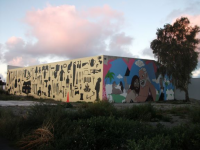
At the end of last year I started a new role at the Christchurch City Council; my full title is Community Arts Advisor. In the first few weeks when people would ask what I was doing I would clip the title and say “Arts Advisor”—it seemed more straightforward. It also mitigated any confusion around “Community Art”—a discipline with a specific history of development and its own parameters.
The Tate UK describes community art as “artistic activity that is based in a community setting, characterised by interaction or dialogue with the community and often involving a professional artist collaborating with people who may not otherwise engage in the arts.” Creative New Zealand has a broader definition, recognising three core strands of community arts activity: Community cultural development, maintenance and transmission of cultural traditions, and Leisure and recreation activities.
The Tate’s definition is probably the one that most people associate with community arts. It is also the least relevant when considering our remit. Creative New Zealand’s definition, for the most part, also refers to modes of practice rather than to who or what is being served. A more useful way of thinking about community arts is through the lens of communities of practice, groups of people who "share a concern or a passion for something they do and learn how to do it better as they interact regularly".
Framing community arts as an ecology of various communities of practice encourages multitudinous and dynamic thinking. This ecology is made up of many, often overlapping, communities that range professional and non-professional, self-taught and academically-trained, traditional and contemporary. If we think of community arts as an ecology, the symbiotic relationship between makers and audiences becomes strikingly clear. Makers and doers nearly always represent the most engaged audiences and subsequently produce work in direct relation to their environment. Community arts are not the antitheses of “professional arts”, they are, in fact, the bedrock and fuel for professional arts to exist.
Toi Ōtautahi, a strategy for arts and creativity in Ōtautahi Christchurch is focused on creating an environment where creative people want to live, work, and produce work. This means that artists are able - and supported - to create work wherever they are in their practice trajectory whilst acknowledging that an ecology requires people and organisations to operate at a range of levels and with diverse goals and purposes. This understanding of community arts as an ecology is reinforced by the inclusion of foundational strategic partners in Toi Ōtautahi. Creative New Zealand, the Rātā Foundation, a mana whenua representative, and ChristchurchNZ have all signed-on to support the delivery of the strategy.
The first part of the implementation of the strategy is a series of hui across the city designed to connect practitioners and funders, to update our communities and to listen. Our first hui for Māori artists and practitioners took place 23 February, a second hui focusing on those living in the East will take place on 3 March. Please contact a community arts advisor if you would like to attend. Email: artsadvisors@ccc.govt.nz
IMAGE
- Wayne Youle’s mural I seem to have temporarily misplaced my sense of humor and community artist Richard aka Pops, on the corner of Colombo and Sandyford streets in Sydenham, 2012
